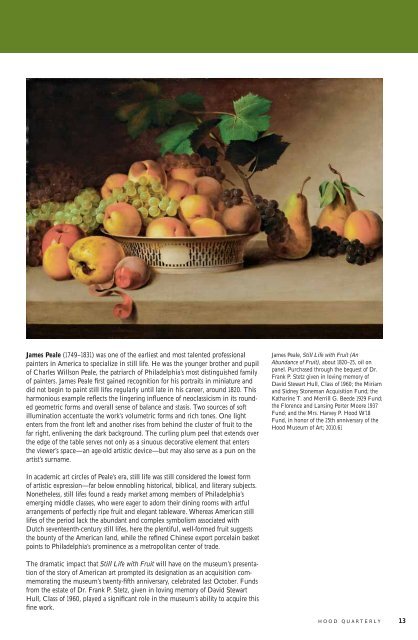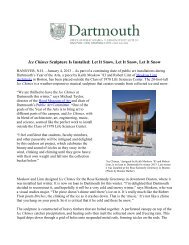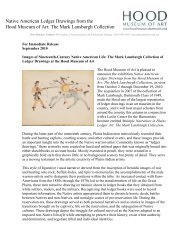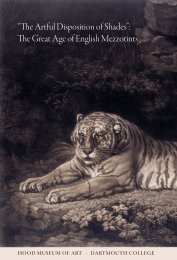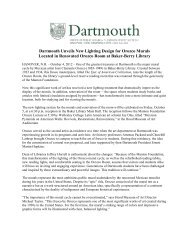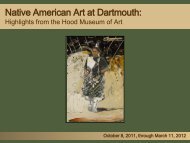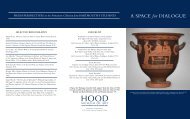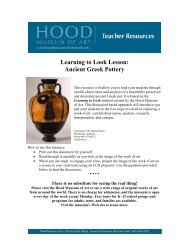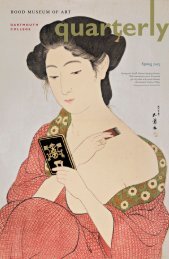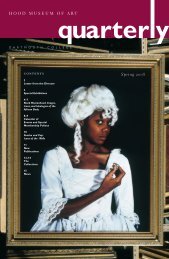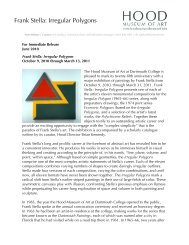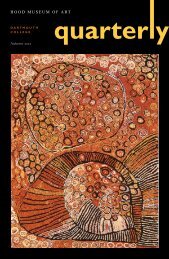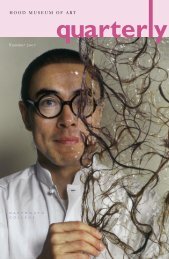Spring/Summer 2011 - Hood Museum of Art - Dartmouth College
Spring/Summer 2011 - Hood Museum of Art - Dartmouth College
Spring/Summer 2011 - Hood Museum of Art - Dartmouth College
Create successful ePaper yourself
Turn your PDF publications into a flip-book with our unique Google optimized e-Paper software.
James Peale (1749–1831) was one <strong>of</strong> the earliest and most talented pr<strong>of</strong>essional<br />
painters in America to specialize in still life. He was the younger brother and pupil<br />
<strong>of</strong> Charles Willson Peale, the patriarch <strong>of</strong> Philadelphia’s most distinguished family<br />
<strong>of</strong> painters. James Peale first gained recognition for his portraits in miniature and<br />
did not begin to paint still lifes regularly until late in his career, around 1820. This<br />
harmonious example reflects the lingering influence <strong>of</strong> neoclassicism in its rounded<br />
geometric forms and overall sense <strong>of</strong> balance and stasis. Two sources <strong>of</strong> s<strong>of</strong>t<br />
illumination accentuate the work’s volumetric forms and rich tones. One light<br />
enters from the front left and another rises from behind the cluster <strong>of</strong> fruit to the<br />
far right, enlivening the dark background. The curling plum peel that extends over<br />
the edge <strong>of</strong> the table serves not only as a sinuous decorative element that enters<br />
the viewer’s space—an age-old artistic device—but may also serve as a pun on the<br />
artist’s surname.<br />
James Peale, Still Life with Fruit (An<br />
Abundance <strong>of</strong> Fruit), about 1820–25, oil on<br />
panel. Purchased through the bequest <strong>of</strong> Dr.<br />
Frank P. Stetz given in loving memory <strong>of</strong><br />
David Stewart Hull, Class <strong>of</strong> 1960; the Miriam<br />
and Sidney Stoneman Acquisition Fund; the<br />
Katharine T. and Merrill G. Beede 1929 Fund;<br />
the Florence and Lansing Porter Moore 1937<br />
Fund; and the Mrs. Harvey P. <strong>Hood</strong> W’18<br />
Fund, in honor <strong>of</strong> the 25th anniversary <strong>of</strong> the<br />
<strong>Hood</strong> <strong>Museum</strong> <strong>of</strong> <strong>Art</strong>; 2010.61<br />
In academic art circles <strong>of</strong> Peale’s era, still life was still considered the lowest form<br />
<strong>of</strong> artistic expression—far below ennobling historical, biblical, and literary subjects.<br />
Nonetheless, still lifes found a ready market among members <strong>of</strong> Philadelphia’s<br />
emerging middle classes, who were eager to adorn their dining rooms with artful<br />
arrangements <strong>of</strong> perfectly ripe fruit and elegant tableware. Whereas American still<br />
lifes <strong>of</strong> the period lack the abundant and complex symbolism associated with<br />
Dutch seventeenth-century still lifes, here the plentiful, well-formed fruit suggests<br />
the bounty <strong>of</strong> the American land, while the refined Chinese export porcelain basket<br />
points to Philadelphia’s prominence as a metropolitan center <strong>of</strong> trade.<br />
The dramatic impact that Still Life with Fruit will have on the museum’s presentation<br />
<strong>of</strong> the story <strong>of</strong> American art prompted its designation as an acquisition commemorating<br />
the museum’s twenty-fifth anniversary, celebrated last October. Funds<br />
from the estate <strong>of</strong> Dr. Frank P. Stetz, given in loving memory <strong>of</strong> David Stewart<br />
Hull, Class <strong>of</strong> 1960, played a significant role in the museum’s ability to acquire this<br />
fine work.<br />
HOOD QUARTERLY 13


